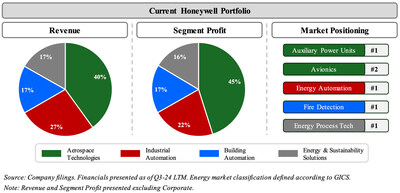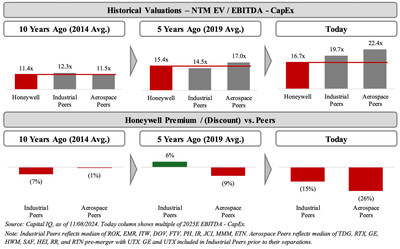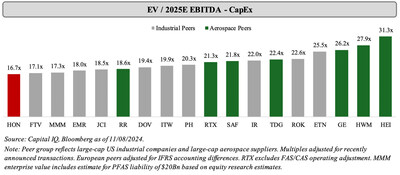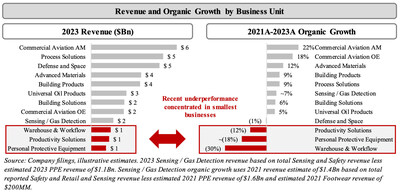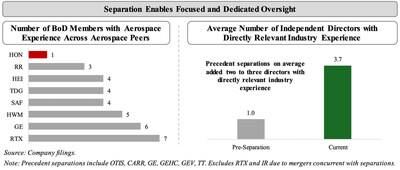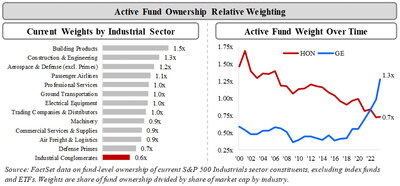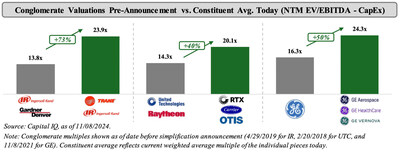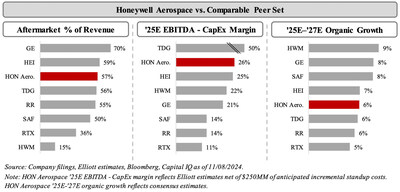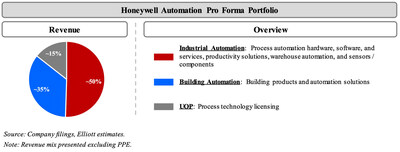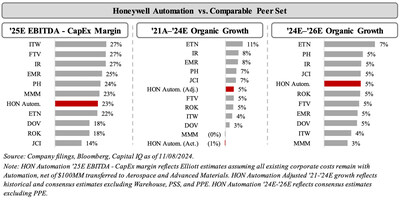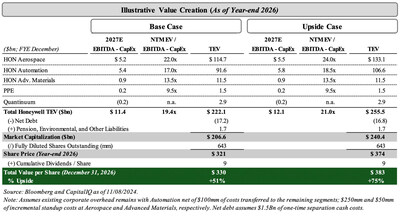Elliott Sends Letter to the Board of Directors of Honeywell International Inc.
Elliott Investment Management has disclosed a more than $5 billion investment in Honeywell International (NYSE: HON) and is calling for the company to separate into two independent entities. Elliott proposes splitting Honeywell into Honeywell Aerospace and Honeywell Automation, arguing this separation could drive share-price gains of 51-75% over the next two years. The investment firm cites uneven execution, inconsistent financial results, and underperforming share price over the last five years as key reasons for the proposed restructuring. Elliott believes the conglomerate structure no longer suits Honeywell and that separation would benefit both entities through simplified strategies, focused management, and improved capital allocation.
Elliott Investment Management ha rivelato un investimento di oltre 5 miliardi di dollari in Honeywell International (NYSE: HON) e sta chiedendo che l'azienda si separi in due entità indipendenti. Elliott propone di dividere Honeywell in Honeywell Aerospace e Honeywell Automation, sostenendo che questa separazione potrebbe portare a guadagni del prezzo delle azioni del 51-75% nei prossimi due anni. La società di investimento cita l'esecuzione disomogenea, risultati finanziari incoerenti e un prezzo delle azioni sottoperformante negli ultimi cinque anni come motivi chiave per la ristrutturazione proposta. Elliott crede che la struttura conglomerata non si adatti più a Honeywell e che la separazione avvantaggerebbe entrambe le entità attraverso strategie semplificate, gestione focalizzata e un'allocazione migliorata del capitale.
Elliott Investment Management ha revelado una inversión de más de 5 mil millones de dólares en Honeywell International (NYSE: HON) y está pidiendo que la empresa se separe en dos entidades independientes. Elliott propone dividir Honeywell en Honeywell Aerospace y Honeywell Automation, argumentando que esta separación podría impulsar ganancias en el precio de las acciones del 51-75% en los próximos dos años. La firma de inversión cita la ejecución desigual, resultados financieros inconsistentes y un precio de acción de bajo rendimiento durante los últimos cinco años como razones clave para la reestructuración propuesta. Elliott cree que la estructura conglomerada ya no se adapta a Honeywell y que la separación beneficiaría a ambas entidades a través de estrategias simplificadas, gestión enfocada y una mejor asignación de capital.
엘리엇 투자 관리가 허니웰 인터내셔널 (NYSE: HON)에 50억 달러 이상의 투자를 밝혔으며 회사가 두 개의 독립된 법인으로 분리될 것을 요구하고 있습니다. 엘리엇은 허니웰을 허니웰 항공우주와 허니웰 자동화로 나누는 것을 제안하며, 이 분리가 향후 2년간 주가를 51-75% 상승시킬 수 있다고 주장하고 있습니다. 투자 회사는 지난 5년 동안의 불균형한 실행, 일관되지 않은 재무 결과 및 저조한 주가를 제안된 구조조정의 주요 이유로 지적하고 있습니다. 엘리엇은 대기업 구조가 더 이상 허니웰에 적합하지 않으며, 분리가 두 개의 법인 모두에게 단순화된 전략, 집중된 관리 및 개선된 자본 배분을 통해 이익이 될 것이라고 믿고 있습니다.
Elliott Investment Management a révélé un investissement de plus de 5 milliards de dollars dans Honeywell International (NYSE: HON) et demande à ce que l'entreprise se sépare en deux entités indépendantes. Elliott propose de diviser Honeywell en Honeywell Aerospace et Honeywell Automation, arguant que cette séparation pourrait entraîner des gains de prix des actions de 51 à 75 % au cours des deux prochaines années. La société d'investissement cite une exécution inégale, des résultats financiers incohérents et un prix des actions sous-performant au cours des cinq dernières années comme raisons clés de la restructuration proposée. Elliott estime que la structure de conglomérat ne convient plus à Honeywell et que la séparation serait bénéfique pour les deux entités grâce à des stratégies simplifiées, une gestion ciblée et une meilleure allocation du capital.
Elliott Investment Management hat eine Investition von über 5 Milliarden US-Dollar in Honeywell International (NYSE: HON) offengelegt und fordert, dass das Unternehmen in zwei unabhängige Einheiten aufgespalten wird. Elliott schlägt vor, Honeywell in Honeywell Aerospace und Honeywell Automation zu trennen und argumentiert, dass diese Trennung in den nächsten zwei Jahren zu Kursgewinnen von 51-75% führen könnte. Die Investmentgesellschaft nennt ungleiche Ausführung, inkonsistente finanzielle Ergebnisse und einen unterdurchschnittlichen Aktienkurs in den letzten fünf Jahren als wichtige Gründe für die vorgeschlagene Umstrukturierung. Elliott ist der Ansicht, dass die Konglomeratsstruktur nicht mehr zu Honeywell passt und dass eine Trennung beiden Einheiten durch vereinfachte Strategien, fokussiertes Management und verbesserte Kapitalallokation zugutekommen würde.
- Elliott's $5 billion investment represents strong confidence in Honeywell's potential
- Proposed separation could lead to 51-75% share price increase over two years
- Both resulting companies would be sector leaders in their respective markets
- Separation would enable improved capital allocation and operational performance
- Company has shown uneven execution over past five years
- Share price has underperformed after last six quarterly earnings
- Current conglomerate structure is causing operational inefficiencies
- Trading at 25% discount to aerospace peers
Discloses More Than
Calls for Honeywell to Separate Into Two Industry-Leading Independent Companies
Sees 51
Full Letter Available at ElliottLetters.com
Honeywell is an iconic pillar of the American industrial complex and remains a world-class company with market-leading assets, Elliott wrote. But uneven execution, inconsistent financial results and an underperforming share price have diminished the Company's strong record of value creation over the last five years. The conglomerate structure that once suited Honeywell no longer does, and the time has come to embrace simplification.
In order to realize its full potential, Elliott recommended that Honeywell pursue a separation of Aerospace and Automation. Both entities would be sector leaders and be better positioned to thrive operationally, serve customers and employees, and create long-term value for shareholders.
As independent entities, Honeywell Aerospace and Honeywell Automation would benefit from simplified strategies, focused management, improved capital allocation, better operational performance, enhanced oversight, and numerous other benefits now enjoyed by dozens of large businesses that have moved on from the conglomerate structure, including former conglomerates General Electric, United Technologies, and many more.
According to the letter, Elliott believes there is a tremendous opportunity for value creation at Honeywell. This includes an enhanced strategic focus that will allow each company to drive improved operating performance and, a set of simplified investment narratives that will deliver superior valuations. Elliott believes a separation of Aerospace and Automation would result in share-price gains of
Elliott said it hopes its letter to Honeywell is received in the same spirit in which it was sent: A desire to work together to help Honeywell achieve its full potential. Elliott requested an opportunity to meet with the Company to advance the shared commitment to Honeywell's success.
The letter can be downloaded at ElliottLetters.com.
The full text of the letter follows:
November 12, 2024
Honeywell International Inc.
855 S. Mint Street
Dear Members of the Board:
We are writing to you on behalf of funds managed by Elliott Investment L.P. (together with such funds, "Elliott" or "We"). Elliott has made an investment of more than
For over a century, Honeywell has been an iconic pillar of the American industrial complex, pioneering technologies that have had broad and profound impact. For decades, Honeywell's operating performance delivered outstanding financial results, benefiting investors and employees.
Honeywell remains a world-class company with market-leading assets. However, over the last five years, uneven execution, inconsistent financial results and an underperforming share price have diminished its strong record of value creation.
We believe these challenges have a clear cause and a straightforward solution: The conglomerate structure that once suited Honeywell no longer does, and the time has come to embrace simplification.
Our letter today outlines why we believe Honeywell should separate into two standalone companies – Honeywell Aerospace and Honeywell Automation – to create two sector leaders better positioned to thrive operationally, serve customers and employees, and create long-term value for shareholders.
As independent entities, Honeywell Aerospace and Honeywell Automation would benefit from simplified strategies, focused management, improved capital allocation, better operational performance, enhanced oversight, and numerous other benefits now enjoyed by dozens of large businesses that have moved on from the conglomerate structure.
In addition, we believe these new companies will each benefit from a clear and attractive investment narrative that will help remedy Honeywell's depressed valuation. As the work we present in this letter shows, we believe the market will generously reward the time and effort required to separate these businesses. In fact, we believe a separation could result in share price upside of 51
Our letter today is organized as follows:
- Our Investment in Honeywell
- Honeywell Today
- The Case for Simplification
- A Transformational Opportunity
- The Path Forward
Honeywell is a great company, and its performance as an investment should match. We are sharing these views with you, and the broader market, to draw attention to this unique and compelling value creation opportunity in the hopes of building a consensus for the best path forward.
I. Our Investment in Honeywell
Founded in 1977, Elliott is one of the oldest private investment firms under continuous leadership and manages approximately
Additionally, we have benefited from our significant experience in each of the specific sub-sectors most relevant to Honeywell, including as board members and operators. To cite a few specific recent examples: Within aerospace, an Elliott partner has served on the board of Howmet Aerospace for the past seven years; Elliott is also highly active in the energy sector, including as investors and owners of multiple upstream and downstream oil and gas companies; and earlier this year, in the building automation space, we worked constructively with Johnson Controls on its well-received oversight and portfolio changes. These experiences, among many others, provide us with the necessary breadth and depth to evaluate Honeywell and all of its constituent businesses.
Through our experience and diligence, we believe we have developed a strong understanding of Honeywell's complexities, challenges and opportunities. This effort has deepened our admiration for Honeywell, reinforced our appreciation of its global importance and underscored the urgency of restoring its success.
II. Honeywell Today
Honeywell is an iconic American company with a history spanning more than 100 years. While it has experienced significant evolution over time, Honeywell in its current form traces its roots back to the 1999 merger of Honeywell and AlliedSignal. That combination created a complex, conflicted organization, which fell into further disarray after its proposed acquisition by GE in 2000 was ultimately blocked. From that challenged state, former CEO David Cote executed one of the great turnaround success stories in corporate history.
Years of Mr. Cote's portfolio-shaping and visionary leadership helped Honeywell secure "great positions in good industries," as he often put it. Today, Honeywell enjoys a broad portfolio of market-leading assets that span aerospace & defense, industrial automation, building automation and energy & sustainability solutions. Nearly all of these end markets are experiencing secular growth, with Honeywell holding leading market shares in each. The result is a collection of high-quality assets that each individually represent highly attractive businesses.
See Exhibit 1: Current Honeywell Portfolio.
Among Honeywell's collection of best-in-class businesses, Honeywell Aerospace stands out as its crown jewel. Against an industry backdrop of significant secular growth, Honeywell Aerospace is a top-five global commercial aerospace supplier with a broad offering of limited-life proprietary products across all major platforms, benefiting from a long tail of captive aftermarket sales. In the industry, Honeywell is known as a technology leader that has succeeded in balancing industry-leading R&D spending with near best-in-class operating margins.
Beyond Aerospace, Honeywell contains similarly impressive assets aligned with core global growth trends in automation and energy transition. This portfolio has been assembled over decades, resulting in a leading global installed base of Honeywell products across process automation, energy technology, and commercial buildings. In each of these markets, Honeywell owns proprietary intellectual property that drives efficiencies for customers while generating robust profitability and secular growth for Honeywell.
Buoyed by this strong collection of assets, Honeywell propelled itself forward for years with market-leading operational rigor and continuous improvement, driving consistent margin expansion and compiling an enviable track record of sustained execution. Prior to the last five years, Honeywell's remarkable consistency drove the highest Earnings per Share (EPS) growth rate among its diversified industrial peers, as well as best-in-class shareholder returns.
See Exhibit 2: EPS Growth and Total Shareholder Return vs. Peers.
As the chart above shows, Honeywell has spent the better part of this century performing not only as a top-tier company, but also as a top-tier investment. And to be clear, Honeywell remains a terrific company. But as an investment, the picture has changed meaningfully.
From Leader to Laggard
Once an operational powerhouse whose stellar financial results generated market-leading returns, Honeywell's stock has languished over the past five years. Since 2019, Honeywell's EPS growth has been at the low end of its peer set and, unsurprisingly, its shareholder returns have been equally disappointing. As discussed later in this letter, this underperformance is a direct result of a suboptimal corporate structure that has led to inconsistent operational execution, a diversified portfolio beset with numerous challenges and the lack of a cohesive investor narrative.
See Exhibit 3: Last 5 Years – EPS Growth and Total Shareholder Return vs. Peers.
Honeywell has now vastly underperformed all businesses except for 3M, which has struggled with substantial environmental liabilities, and Fortive, which recently announced a break-up as a means of improving its business focus and value.
Over the past five years in particular, Honeywell's share price has dramatically underperformed both its peers and the broader market. More recently, this underperformance has been particularly acute. In fact, the Company's share price has declined after all six of its most recent quarterly earnings, with three of these events ranking among Honeywell's four largest negative earnings reactions in the last 15 years.
"For a company that used to guide conservative and be able to manage whatever came their way to drive upside… missing a somewhat aggressive guidance and reducing margins in the meantime, shows how this is not the same Honeywell." (JP Morgan, July 2024)2
The unfortunate result is that Honeywell's cumulative total shareholder return has underperformed benchmarks across virtually all time periods over the past ten years. This underperformance affects not only investors, but also current and former Honeywell employees, who hold a significant portion of their compensation and pensions in the Company's stock.
See Exhibit 4: Relative Total Shareholder Return.
Most disappointing is that this significant underperformance has occurred despite a historically strong end-market for aerospace & defense, which accounts for nearly half of Honeywell's profit. While aerospace-industry valuations have expanded significantly in recent years, Honeywell's multiple has remained flat, and the Company currently trades at more than a
See Exhibit 5: Historical Valuations – NTM EV /EBITDA - CapEx and Honeywell Premium / (Discount) vs. Peers.
As the charts above show, Honeywell today trades at a material discount to peers and a historically cheap relative valuation. In fact, Honeywell now trades below every single one of its diversified industrial and aerospace supplier peers.3
See Exhibit 6: EV / 2025E EBITDA – CapEx.
These charts tell the story of why we are here. Under David Cote's leadership, Honeywell transformed from a poorly run business into a high-performing operation whose industry-leading earnings growth delivered best-in-class shareholder returns. Today, the situation is quite different. What was once an operational turnaround story with meaningful room for improvement is now a mature business with an uncertain path to value creation in its current form. Flawless execution, accelerating growth and a compelling long-term narrative are no longer untapped sources of outperformance – they are table stakes. And achieving them is made significantly more difficult by Honeywell's status as one of the last remaining industrial conglomerates.
Of course, not every conglomerate is doomed to struggle with performance. There are examples of diversified, multi-line businesses that have succeeded, even over long periods of time. But each case needs to be evaluated on the merits, and success in the past does not ensure optimal performance in the future – especially when the menu of options for investors has evolved in ways that have made conglomerates less attractive as investments.
In Honeywell's case, the Company has struggled even with the table-stakes part of the equation in recent years, and the significant deterioration in its share price performance and valuation reflects a loss of faith among Honeywell's investors that it can overcome the limitations of its conglomerate structure. Fortunately, there is a straightforward solution at hand – a single step that can vastly improve this great company's likelihood of success and create substantially more value than any of the more incremental actions contemplated to date.
III. The Case for Simplification
Modern-day Honeywell is among the most sprawling, diversified multi-industry businesses around. Externally, Honeywell has 12 different public reporting lines, each of which could operate as a sizeable standalone public company. Internally, Honeywell maintains more than 700 different sites with ~100,000 employees spread across ~80 countries. Honeywell is a truly global company touching many parts of the economy. The breadth of the portfolio, coupled with the depth of expertise required to remain a leader in each of these industries, results in a company that is unwieldy for all parties – from management to investors.
"Over time the company has become unwieldy, arguably uninvestable." (Melius, October 2024)
Honeywell's struggle with complexity is neither unique nor surprising; it is endemic to the conglomerate operating model. The issues that Honeywell is dealing with today have already been studied and resolved by many of the country's most important companies, including GE, United Technologies, Alcoa, Danaher, Tyco, Ingersoll Rand, Johnson Controls, ITT, Pentair, DuPont and countless others that have found success through simplification. There is abundant evidence that simplification results in better business performance, and the industrials landscape is rife with recent successful examples of former conglomerates that improved performance, enhanced valuation and generated immense shareholder returns through separation.
"The trend toward a refined and simplified portfolio is a journey that has been underway for nearly two decades … GE's most recent breakup announcement could perhaps be signal of a near peak in the unwinding of the conglomerate structure…The spin-offs of OTIS and CARR from UTX are the most recent example of companies freed from corporate shackles that fared better independently and repudiated the conglomerate model." (Mizuho, September 2024)
Against this backdrop of simplification initiatives undertaken by its closest competitors, Honeywell's complexity stands apart. Fortunately, Honeywell itself has acknowledged that excess complexity can be an impediment to business performance and shareholder value creation. To CEO Vimal Kapur's credit, he has initiated several incremental portfolio changes and has spoken in depth about working towards a "simpler, clearer strategic focus and clearly defined Honeywell value proposition for our customers, investors and employees."
Honeywell has recently taken some initial actions to simplify – spinning off Advanced Materials, for example. These are steps in the right direction, but they are not enough. They do not address the root of Honeywell's complexity issues – its status as a diversified conglomerate.
"[Advanced Materials] Spin makes sense, but is it enough?...While we welcome this news, we think much more may be needed to move the needle." (UBS, October 2024)
A Better Path: A Simplified Honeywell
Now is the time for Honeywell to chart a path to success similar to the one traversed by many of its peers – with its leadership team operating from a position of strength towards a simplified structure that enables greater focus and operational excellence. By separating into Honeywell Aerospace and Honeywell Automation – with the latter capturing what is today Industrial Automation, Building Automation and Energy & Sustainability Solutions ("ESS") – into two stand-alone, industry-leading companies, Honeywell would be best positioned to reverse its recent stagnation, improve operational performance, and deliver long-term value for shareholders.
The benefits of a separation can be broken down into two primary areas: A) an enhanced strategic focus that will allow each company to drive improved operating performance, and B) a set of simplified investment narratives that will deliver superior valuations.
Together, we believe these factors will drive both meaningful business improvements and substantial value creation, as demonstrated by many of the peers that have undertaken structural simplification. We will take each of the core benefits in turn, contrasting this better path with the status quo.
A. Enhanced Strategic Focus Will Drive Improved Operating Performance
Honeywell today suffers from operational issues that are common to conglomerates: specifically, its smaller businesses suffer from a lack of management attention, its larger businesses suffer from competition for investment dollars with other parts of the portfolio, and the whole conglomerate suffers from the difficulty of managing such a large and sprawling organization.
Honeywell's Streamlined Businesses Will Perform Better Post-Simplification
As highlighted above, the extreme complexity inherent in managing 12 large business lines leaves Honeywell's leadership constantly contending with multiple operational challenges at once. In the most recent quarter alone, Honeywell suffered from a series of challenges as wide-ranging as unexpected delays in Process Solutions and UOP, softer short-cycle sales in Industrial Automation, discrete supply chain disruptions in Aerospace, catalyst delivery push-outs, uncertainty caused by geopolitical events, and a facility fire. The only certainty in a portfolio as complex as Honeywell's is that management will have to contend with many unpredictable problems at once, affecting the time and attention it can devote to the rest of the portfolio.
"Which leaves the elephant in the room – what does HON need to spin/sell in order to get this portfolio into something that is manageable? Not just manageable for HON – and avoiding the 'whack a mole' trend we have experienced here – but manageable for investors?" (Melius, July 2024)
In recent years, Honeywell's operational issues have been most pronounced in the Industrial Automation segment (previously known as "SPS"). Specific areas of underperformance in Honeywell's SPS segment include Warehouse & Workflow Solutions ("Warehouse"), Productivity Solutions & Services ("Productivity"), and PPE, all of which have declined at a double-digit rate since 2021.
See Exhibit 7: Revenue and Organic Growth by Business Unit.
We believe that Honeywell's conglomerate model has contributed to this underperformance. Honeywell's products themselves are competitive – our survey work consistently highlighted that more than
The fact that these issues cropped up in the Company's smallest businesses is completely understandable given Honeywell's current structure. How can Honeywell's corporate leadership dedicate the same amount of mindshare to its smallest businesses – which each amount to ~
In fact, former Honeywell CEO Darius Adamczyk described this dynamic quite well in 2017: "I think today, we're in roughly, call it, 7 to 9 end-markets depending upon how you think about it. And some of them are very small that, frankly, don't move the needle that much… And that's a factor, right, because I want my leadership focused on things that matter. And even smaller businesses that you'd say, 'Well, okay, but that doesn't move the needle either way.' It's true, but I want the focus from my management teams on things that matter and smaller things sometimes can be a distraction."
Warehouse, Productivity and PPE are small businesses within Honeywell's portfolio, amounting to less than
See Exhibit 8: Honeywell Growth Excluding SPS is Above Peers – 1Q'22 to 3Q'24.
"HON's organic growth has only outperformed MI/EE peers in two of the last eleven years – and we believe that the most obvious reason for this is the company's conglomerate structure, which has become rare in our coverage universe." (Deutsche Bank, April 2024)
Fortunately, many of the drivers of this underperformance are addressable, and we believe that as a more singularly focused company – separate from Aerospace – Honeywell Automation will be best positioned to focus on improving its areas of weakness and driving better execution. While each situation is unique, the recurring narrative that has played out following the simplification of Honeywell's peers has been one of smaller, more agile organizations achieving vast operational improvements over the performance they delivered within a conglomerate structure.
"You may ask, why does being a pure-play matter? We've highlighted five reasons why being a pure-play matters and I'll focus on two. First, we will continue relentless reinvestments to fuel market-leading innovation. Our purpose-driven strategy is
We can see these operating improvements at work at other companies that have simplified into more streamlined entities. We observed a pattern of improved operating performance across almost every comparable example we evaluated, with a few notable precedents below:
See Exhibit 9: Precedent Separations.
"Listen, I'm really pleased with our performance since spin. We're a more agile company. We're a focused company. We're executing on our strategy, and I think we're seeing a pace that just wasn't inherent in a conglomerate." (Judy Marks, CEO of Otis, September 2022)
Simplification Will Reduce Honeywell's Competing Investment Priorities
Competition for fixed investment dollars across a conglomerate's portfolio creates challenges for both organic investments and M&A. Such diversified organizations often suffer from suboptimal R&D allocation, as competing priorities and internal frameworks can hinder the efficient allocation of investment dollars. Over time, this dynamic can erode the competitive position of certain businesses – especially those competing with pure-plays.
In Honeywell's case, its underlying business units not only compete with one another for investment allocation, but also have to compete against broader corporate initiatives. For example, consider Quantinuum. While we make no judgment on Quantinuum itself, it is reasonable to question whether Honeywell's investing in quantum computing is a distraction – in either investment dollars or management mindshare – from its core businesses.
A pure-play Honeywell Aerospace, for instance, would be unlikely to pursue such an ambitious venture outside its core focus. By contrast, Honeywell's pure-play competitors enjoy a distinct advantage, as they can direct all investment into their core businesses without having to contend with this kind of internal competition. A separation would sharpen Honeywell's focus, enabling a more efficient allocation of resources toward its core business priorities.
"As I've gotten into the details, what I've learned is that ex-Solventum R&D investment for core 3M, which is running about
In addition to competing internal priorities, there is also a natural tension between allocating inorganic investment to Honeywell Aerospace, where Honeywell already has a broad portfolio, versus investing in smaller segments to increase diversification and promote portfolio balance. We believe this helps explain the historical lack of M&A at Honeywell Aerospace, despite generating Honeywell's greatest profits and garnering its highest valuation. Over the past two decades, Aerospace generated
"I think the biggest differentiating factor is that we have full access to our own cash flow and working capital. And the significance of that is that these businesses have tended to be underinvested in from a capital deployment relative to M&A in the last 5 to 8 years … The opportunity for us to spend that on value-accretive M&A is going to be incredibly impactful." (Jennifer Honeycutt, CEO of Veralto following its separation from Danaher, November 2023)
All of Honeywell's Businesses Will Benefit from More Focused Oversight
As separate public entities, Honeywell Aerospace and Honeywell Automation would benefit from dedicated boards with more tailored experience as well as enhanced management focus and alignment.
For example, only one of Honeywell's directors possesses Aerospace experience (specific to airlines), despite the importance of the Aerospace business to Honeywell. This lack of industry-specific expertise is common among conglomerates, whose boards typically include fewer directors with specialized knowledge for each division. However, when conglomerates restructure, the resulting pure-play companies often strengthen their boards by adding directors with relevant expertise, leading to overall enhancements in strategic oversight.
See Exhibit 10: Separation Enables Focused and Dedicated Oversight.
"Speaking of the team, speaking of alignment, one of the other benefits that we were very keen to realize in the spins is the creation of 3 focused Boards chock-full of domain expertise, fit for purpose in Healthcare, Aerospace and in Energy." (Larry Culp, CEO of GE, March 2024)
In the area of management focus and retention, consider that Honeywell's business leaders currently have only
"If you think about a spin, what does it do right away? It attracts great talent … If I take Wayde McMillan, my CFO, who was a public company CFO before this job, if you would have called him and said, 'Hey, why don't you come and run the Solventum sub-business of 3M and you can be a Vice President of Finance, he would just hang up the phone." (Bryan Hanson, CEO of Solventum, March 2024)
B. A Simplified Investment Narrative Will Drive Superior Valuations
In an earlier era, conglomerates served a less sophisticated investor base by providing investment diversification. The idea was simple: With just one ticker, an investor could gain exposure to numerous end markets at once, achieving stability without complex portfolio construction.
Today, however, the investment landscape looks far different. Investors are now far more sophisticated, and with the rise of ETFs and indices, they can easily diversify on their own – targeting specific end markets where they want outsized exposure or constructing their own diversified portfolios. No longer do investors need, or even want, management teams to handle that allocation for them.
This shift in investor preferences is most evident in how capital is allocated between conglomerates and pure-play businesses – in effect, how investors "vote with their feet." Active fund managers' weighting towards industrial conglomerates is now at a multi-decade low, and by far the lowest of all S&P500 Industrial sectors. At the same time, observing the relative fund weightings of Honeywell and GE since 2000 is instructive. While GE was under-owned by investors for decades, its recent simplification has led to a dramatic re-weighting. On the other hand, institutional ownership of Honeywell has been in a long-term trend downwards.
See Exhibit 11: Active Fund Ownership Relative Weighting.
"Very simply, HON is a complicated business and conglomerate models are getting clear discounts vs. companies with greater end market focus." (UBS, October 2024)
As investor preference has shifted in favor of pure-play businesses, the theory that a conglomerate provides insulation from the vagaries of the business cycle has given way to the reality that underperformance in one part of a conglomerate today simply drags down the narrative of the whole. In many ways, the very diversification that once made conglomerates attractive has diminished their appeal.
In addition to weighing down consolidated financial results, the struggles of underperforming businesses tend to overshadow other parts of the portfolio. Today, for instance, the business line with the most pronounced underperformance is Warehouse, the most challenged business within SPS. Despite representing just
This dysfunctional dynamic creates a "least common denominator" effect, where investors' perceptions of Honeywell are only as good as the Company's worst-performing segment. In a company with 12 disparate reporting lines, there will likely always be an underperforming business that serves as a valuation overhang.
"HON shares have chronically underperformed as EPS growth has lagged and better opportunities emerged in pure play names. HON continues to execute well and has strong margins and competitive positions, but its diversification is working against it as investors focus more on whatever is wrong or lagging instead of what is good and leading." (Vertical Research Partners, July 2024)
With this in mind, it is no surprise that Honeywell today is valued at a material discount to its peers. In fact, as shown previously, it has the lowest valuation of any company in its peer set, despite its outsized exposure to the high-value aerospace sector.
Fortunately, many conglomerates in similar situations have been able to remedy their valuation discounts substantially through simplification. GE, United Technologies and Ingersoll Rand have all recently demonstrated the magnitude of business outperformance and value creation that can follow separation. All three separated into two to three more focused assets that subsequently achieved operational outperformance due to greater end-market alignment and agility, which in turn was rewarded with a dramatic value re-rating driven by a simplified narrative and greater investor appeal. When comparing each conglomerate's valuation at the announcement of separation to the valuation of its component averages today, the uplift becomes starkly apparent.
See Exhibit 12: Conglomerate Valuations Pre-Announcement vs. Constituent Avg. Today (NTM EV/EBITDA – CapEx).
Putting it Together
The combination of these two dynamics – improved operating performance and enhanced valuation – has created a substantial amount of value for investors. Since simplifying their previously sprawling structures, all three of the former conglomerates mentioned in the section above have delivered outstanding shareholder returns.
See Exhibit 13: TSR of Peers that Have Pursued Separations (Absolute and Relative to Honeywell) – Since 2019.
"The relentless sector trend of "Urge to Demerge" has transformed most Multi-Industry portfolios over the past five years. Prior to the COVID downturn, the Multi-Industry trend had been in a relentless 'urge to demerge', 'addition by subtraction', and portfolio simplification, with the market generally rewarding higher multiples to more pure-play entities. Portfolios are arguably more simplified today than ever before, and there is really only one remaining large conglomerate that has not gone down the breakup path – Honeywell." (RBC, April 2024)
IV. A Transformational Opportunity
There is a tremendous opportunity for value creation at Honeywell. The unique combination of attractive assets, operational underperformance, a significant valuation disconnect and an actionable pathway for value realization creates the potential for exceptional upside. It is this opportunity that led us to make a multi-billion dollar investment in Honeywell.
In order to realize its full potential, we are recommending that Honeywell pursue a separation of Aerospace and Automation. While a transaction could take a wide range of potential forms, Honeywell is in the enviable position of possessing two industry-leading businesses – Aerospace and Automation – in attractive end markets and with substantial scale. Honeywell Aerospace would be a top-five global aerospace supplier, while Honeywell Automation would be a large-cap multi-industrial with annual revenue of nearly
A Separation is Actionable. Structurally, both businesses are already largely independent and fully capable of thriving on their own. The operations of Honeywell Aerospace are already functionally separate; the business has its own management team, physical headquarters, ERP and other technology systems, manufacturing facilities, detailed financial reporting systems, go-to-market organization, product development and validation team, and supply chain. Some back-office functions and minor inter-segment sales (e.g., sensors) are shared, but these are small in magnitude and easily addressable.
Operationally, Honeywell has long instilled a level of immense discipline throughout its organization. And because the ~100,000 employees who form the foundation of the Company's iconic Honeywell Operating System will be the same ones shepherding its businesses post-separation, their fundamental mindset of operational excellence will ensure continuity. In fact, similar to all of the precedent separations cited above, we would anticipate that operational performance improves as part of a more focused and dedicated company.
Financially, both businesses would be
A Separation is in High Demand. The path we are suggesting is not novel, and we are confident that many have already suggested it to Honeywell's Board and management. Honeywell's equity research analysts, many of whom have followed the industrials sector for decades, have written at length about the potential benefits of a separation. Similarly, our diligence indicates that investors have a strong preference for streamlining Honeywell: Our recent shareholder survey of Industrials investors – a group representing
While shareholders have long hoped for a separation, the current environment presents a distinctly attractive opportunity to do so. We are of course aware that Honeywell has considered the idea of simplification in the past. However, what makes the current situation different is the sheer amount of value that Honeywell can create by pursuing simplification now.
Honeywell Aerospace
The outlook for aerospace suppliers appears brighter today than it has in decades. Industry demand for both new and spare parts is at record highs spurred by a global recovery in travel post-COVID that has far outpaced the industry's ability to restore supply commensurately. Quality issues at OEMs have further constrained supply growth, while simultaneously affording significant pricing power to high-quality suppliers in commercial negotiations. As a result, suppliers are benefiting from the flywheel of a multi-year production recovery coupled with improving pricing and profitability, fueling strong earnings growth for the foreseeable future.
Against this favorable market backdrop, Honeywell Aerospace is a category leader with a near best-in-class financial profile and enviable strategic positioning. It generates its profits primarily from the commercial aftermarket where, relative to peers, Honeywell has (i) a higher proportion of aftermarket revenue, (ii) a higher-margin aftermarket business selling primarily spare parts versus low-margin service work, and (iii) stickier aftermarket revenue given industry-leading adoption of "power by the hour" contracts. As a result, Honeywell Aerospace generates operating margins that are second to only Transdigm's in the industry. What differentiates Honeywell's business further is that it generates this margin profile while also investing substantially more than peers to develop industry-leading technology and solidify its future growth potential.
See Exhibit 14: Honeywell Aerospace vs. Comparable Peer Set.
The result is a high-quality aerospace business operating at the forefront of technology, with near best-in-class margins and a durable trajectory of growth ahead.
From a valuation perspective, Honeywell trades at 16.7x EBITDA - CapEx today, compared to an aerospace peer set that trades between 18.6x and 31.3x. Based on its financial profile and strategic position, we believe Honeywell Aerospace should be valued at a premium relative to the average of its aerospace peer group. For the sake of conservatism, in our Base Case, we assume a valuation of 22.0x NTM EBITDA - CapEx, a discount to the peer median and only a modest premium to Raytheon despite Honeywell Aerospace being a faster-growing business with more than double the profit margins and substantially less exposure to defense prime contracting business. In our Upside Case, we assume a valuation of 24.0x NTM EBITDA - CapEx, a modest premium to the peer median and, in our view, a more reasonable valuation based on the business's financial profile. Although not reflected in either case, there is significant strategic upside optionality that could arise once the Aerospace entity becomes a standalone entity.
See Exhibit 15: Aerospace Valuation in Context – EV / 2025E EBITDA – CapEx.
Every valuation methodology we apply to Honeywell Aerospace reinforces our strong conviction that, as a standalone entity, it should be worth well over
Honeywell Automation
Following its separation from Aerospace as well as the planned dispositions of Advanced Materials and PPE, Honeywell Automation will be a strong, pure-play automation company providing industry-leading solutions for a diversified set of end markets.
See Exhibit 16: Honeywell Automation Pro Forma Portfolio.
Honeywell Automation holds leading positions in many key categories, including global fire detection; distributed control systems; downstream energy technology and catalysts; and renewable energy and technology. Its primary businesses exhibit significant barriers to entry supported by a global installed base accumulated over decades of market leadership. This installed base provides a valuable stream of recurring revenue through software, aftermarket parts and services, and process catalysts.
While recent organic growth has fallen below expectations, we believe this is largely due to explainable, non-recurring factors. Specifically, idiosyncratic events in Warehouse, Productivity and PPE drove significant historical declines, but have begun to stabilize. Further, the opportunity for improved performance as a more focused entity provides upside optionality.
In Warehouse, a single customer representing roughly two-thirds of revenue terminated its partnership with Honeywell in mid-2022, but this customer loss is now largely out of the financials and the underlying end-market growth remains robust. At the same time, the Productivity segment suffered from short-cycle weakness and channel de-stocking, but maintained market share and is poised to benefit from the already emerging cyclical rebound. Lastly, PPE has contributed to significant declines at Honeywell, as it has struggled with the intense demand surge and unwind of COVID-related revenues, exacerbated by its non-core status within the Honeywell conglomerate. However, this business has been reclassified as held for sale.
See Exhibit 17: Honeywell Automation – Recent Underperformance.
Excluding these three businesses, which should no longer serve as drags on Honeywell's financials, Honeywell Automation's historical organic growth rate would have been ~
See Exhibit 18: Honeywell Automation vs. Comparable Peer Set.
Today Honeywell trades at ~16.7x EBITDA - CapEx, compared to an industrial peer set that trades between 17.1x and 25.5x. Despite Honeywell Automation's in-line profitability and growth profile, our Base Case takes the conservative step of assuming 17.0x NTM EBITDA – CapEx, a multiple that remains at a discount to Fortive, 3M and every other diversified industrial peer. Further, while our Base Case does not assume any operating improvement, we would expect a more focused Honeywell Automation to achieve superior operational performance, for all the reasons described above. In our Upside Case, we assume a valuation multiple of 18.5x NTM EBITDA - CapEx, a modest discount to the peer median.
See Exhibit 19: Automation Valuation in Context – EV / 2025E EBITDA – CapEx.
In short, we firmly believe that a stand-alone Honeywell Automation would be a stronger, better-run business valued at approximately
Value Creation Potential
We believe a separation of Aerospace and Automation could yield share price gains of
See Exhibit 20: Illustrative Value Creation (As of Year-end 2016).
This level of value creation would be profound for any company, let alone one of Honeywell's size. However, history would indicate that these assumptions might ultimately prove too conservative. Notably, in three of the most recent comparable examples – United Technologies, GE and Ingersoll Rand – the realized upside from these portfolio moves far exceeded any initial expectations at the time of announcement.
While analysts initially estimated an average of just 10–
"SOTP just doesn't work, mostly because it uses current profits - not the profits generated by a more dynamic entity and it uses P/E or EV/EBITDA comps that are often circular and point to 'average' when spin-off eps growth is often well above average. What the data tells us and our experience with north of 25 spin-offs is that we always seem to underestimate how a focused spin-off entity can create value." (Barclays, May 2017)
See Exhibit 21: Estimated SOTP Upside at Announcement vs. Actual Realized TSR.
V. The Path Forward
We hope this letter is received in the same spirit in which it is shared: A desire to work together to help Honeywell achieve its full potential. Honeywell consists of a collection of market-leading assets, run with an operating system that is the envy of the industry. Despite these advantages, we believe that Honeywell's underlying value far exceeds the value that the market has assigned it today. We suspect the Board and management team agree.
Honeywell is at an inflection point. While its performance has lagged, its market positioning remains sound, and comparable valuations continue to reach new highs. The case for change is clear and compelling, and the path to achieving that change is straightforward: allowing Honeywell Aerospace and Honeywell Automation to stand on their own. We hope you share our view – and the growing market consensus – that now is the right time for Honeywell to take this step in its evolution.
We would like to conclude by requesting an opportunity to meet in person to expand upon the analysis above, to hear your views on this opportunity, and to advance our shared commitment to Honeywell's success. We are available to meet at your earliest convenience.
Sincerely,
Marc Steinberg
Partner
Jesse Cohn
Managing Partner
About Elliott
Elliott Investment Management L.P. (together with its affiliates, "Elliott") manages approximately
1 | As of June 30, 2024. |
2 | Emphasis added to quotes throughout this letter. |
3 | Note: Throughout this letter, we value Honeywell and its peers using an earnings-based methodology, specifically EV / EBITDA – CapEx. This approach accounts for Honeywell's relatively lower capital intensity, the differences in capital structure among peers, and is the best measure of approximating segment-level cash flow. |
Media Contact:
Casey Friedman
Elliott Investment Management L.P.
(212) 478-1780
cFriedman@elliottmgmt.com
![]() View original content to download multimedia:https://www.prnewswire.com/news-releases/elliott-sends-letter-to-the-board-of-directors-of-honeywell-international-inc-302302653.html
View original content to download multimedia:https://www.prnewswire.com/news-releases/elliott-sends-letter-to-the-board-of-directors-of-honeywell-international-inc-302302653.html
SOURCE Elliott Investment Management L.P.







